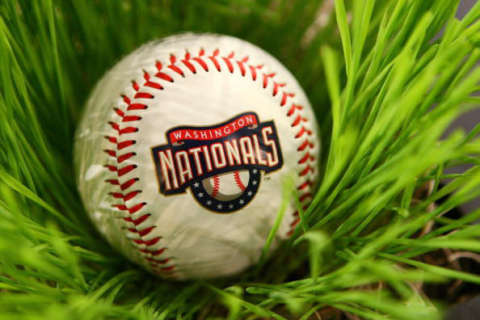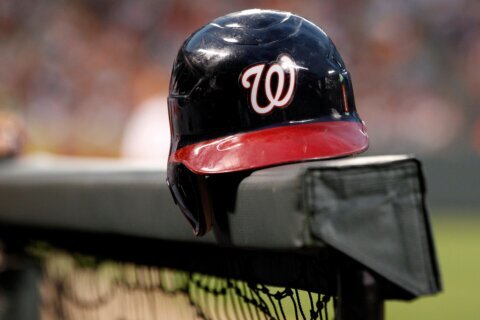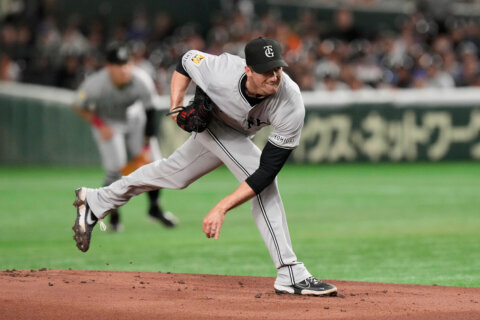Fans boo here at #Nationals Park after the tarp comes out after an hour and fifteen minutes of rainless delay. pic.twitter.com/9pQjtfnCfw
— Audrey Stark (@HighStarkSunday) July 7, 2017
After an hour and 20 mins you tarp the field?? #PoorCustomerService #refund pic.twitter.com/lGjKinhfyX
— Sydney (@SydneyH_23) July 7, 2017
Could be in the 4th inning by now. Still no rain @ 8:10 #WashingtonNationals pic.twitter.com/4L84yleinU
— UTSEAY (@utseay) July 7, 2017
Gotta say that it's ridiculous the #Nationals did not start this game at 7 p.m. as scheduled. Radar doesn't show rain arriving till 9-ish.
— David O'Brien (@DOBrienAJC) July 6, 2017
Over an hour of fine weather and zero explanation or updates. Can you please provide some more information? We deserve better. pic.twitter.com/1D2NPTH7UP
— Brian (@Notorious_H_O_Y) July 7, 2017
Is the bullpen running your public relations department as part of some weekday side-hustle? Because that sure ain't the relief we need!
— Nathan Lean (@nathanlean) July 7, 2017
This is absolutely ridiculous. The metro closes at 1130 how do you expect anyone to get home?
— Wyatt Bensken (@Wyatt_Bensken) July 7, 2017
Unfortunately some of us are couldn't stay all night. Great experience for my son's first game. He didn't see a pitch. #bushleague pic.twitter.com/4pzebxOSZj
— Brian Linn (@LeftCoastHoya7) July 7, 2017
I wouldn't know - after 2 1/2 hours of a non-rain delay I had to go home because, you know, I'm a grown up and have to work. #wheresmyrefund
— bdk628 (@bdk628) July 7, 2017
Paid for #Nationals tickets, #Nationals t-shirt, bought concessions, and been watching #Phillies on jumbo for 1 hr 20 min.
— Carrie Jackson (@jackson_carrie) July 7, 2017
Yall just trying to lose to the Braves twice in one day. I understand
— HawksFanInTN (@JonHenry92) July 7, 2017
WASHINGTON — The adage “a watched pot never boils” certainly applied to the Washington Nationals and their fans during a three-hour delay Thursday night, prompted by the threat of heavy rain that eventually amounted to merely a drizzle.
While rain delays are an accepted reality of baseball, the decision-making and slow-moving weather conditions contributed to a series of events that led to fan frustration, and the team offering freebies to soothe fans who remained in Nats Park.
Twenty-five minutes before the Nats’ scheduled 7:05 p.m. game against the Atlanta Braves, the team announced it would delay the first pitch because of heavy rain that was scheduled to blow through downtown D.C. at about 8. The game finally started more than two hours later.
Friday morning, the team released a statement via Twitter that read in part “Last night’s decision was very difficult” and added that the team understood “some of you had to leave before we even got started. … We appreciate everyone’s patience and support.” Many who responded to the statement noted that there was no offer of compensation to fans who had to leave.
Casual fans may not have known the rationale behind delaying a game when it’s not raining — baseball teams are reluctant to start and stop ballgames because of the wear and tear on starting pitchers’ arms.
“We were told that there was a pretty severe storm coming. The weatherman, as you know, has been wrong before, and it’s hard to really predict weather. We didn’t want to hit the field in bad conditions, start in the rain and then waste a pitcher,” Nats manager Dusty Baker said after the game.
Major League Baseball Rule 3.10 reads: “The home team shall be the sole judge as to whether a game shall not be started because of unsuitable weather conditions or the unfit condition of the playing field, except of the second game of a doubleheader.”
More than an hour after the game was supposed to begin, the grounds crew put the tarp onto the field. Still, no rain.
Typically, rain delays can spark on-field hijinks. A fan tweeted a suggestion to Braves outfielder Ender Inciarte, encouraging the team to do a slip-and-slide on the tarp covering the field.
Can’t. The tarp is dry. https://t.co/Nomy7ROZ7x
— Ender Inciarte (@enderinciartem) July 7, 2017
By 9:08 p.m., the much-anticipated rain finally arrived, providing the cue for more fans to depart the ballpark. However, the precipitation was only a drizzle that the team would typically play through.
After the weather blew through, the game began at 10:10. Many of the 22,724 who paid for tickets were at home, or on their way. Fans who rode Metro to the game did the math and realized the system would be closed by the time the game was over.
With few people in the ballpark, the team invited fans to watch the game they’d already paid for.
Fans with tickets to tonight’s game are welcome to re-enter the ballpark and watch the game.
— Washington Nationals (@Nationals) July 7, 2017
Soon after, the team offered free soda, ice cream and water (fittingly) to fans who braved the delay.
The game ended at 1:20 a.m., with the Braves winning, 5-2.
Nats general manager Mike Rizzo issued a statement:
We monitor the weather very closely via a weather service, along with Major League Baseball. Our decisions on any weather-related issues are made in conjunction with Major League Baseball, opposing teams, umpires, and the players union. Tonight was tough. We could see weather heading our way and wanted to be proactive, but the timing on its arrival kept shifting. We hate when this happens — it’s such a tough spot to be in. Do you start play or not? There are so many factors to consider, including how a midgame delay would impact our players. We know the fans came to see a game, and we hate that we made them wait. We appreciate everyone’s patience tonight.”
While some disappointed fans were critical of the team’s handling of the impending rain, NBC4 meteorologist Chuck Bell said the threat was real.
“Having looked at the radar loop from last night, here’s what I think was going through the mind of the person making the rain-delay decision. At 7 p.m. there was a thunderstorm near Warrenton. It was heading towards Manassas, and if that trend were to continue it would have reached the ballpark between 8 and 8:30. Not wanting thousands of people to be exposed to an electrical storm was the primary goal. That storm, which did become severe with hundreds of cloud-to-ground strikes, ended up tracking more southeast than east, leaving the ballpark largely unaffected,” Bell said.
“Lightning can strike as much as 10 to even 20 miles from the parent storm, so this storm did have the potential to bring lightning to the ballpark. These judgment calls are never easy, but just imagine the alternative headline of a fan or player getting hurt (or worse) from a storm,” said Bell.








